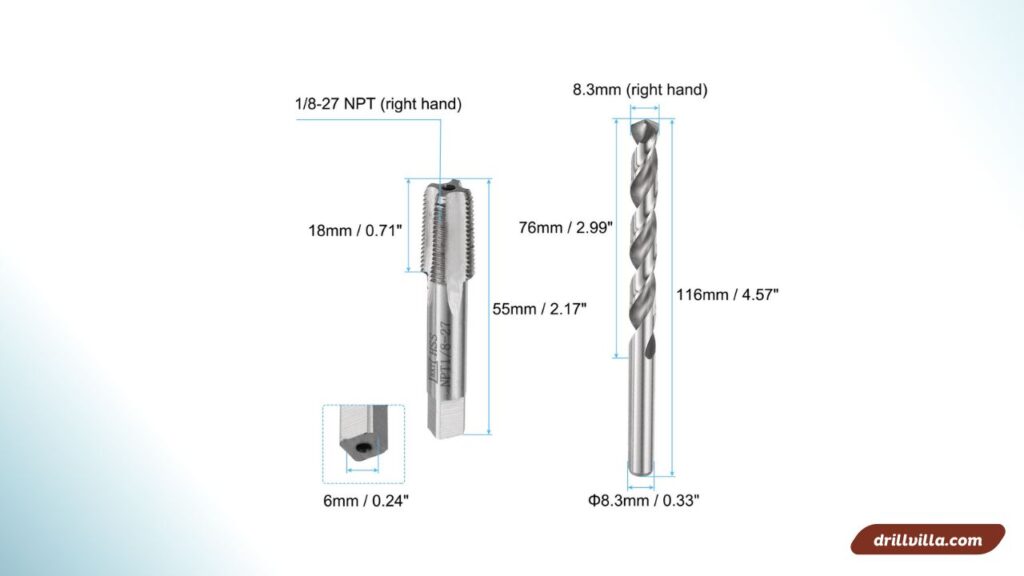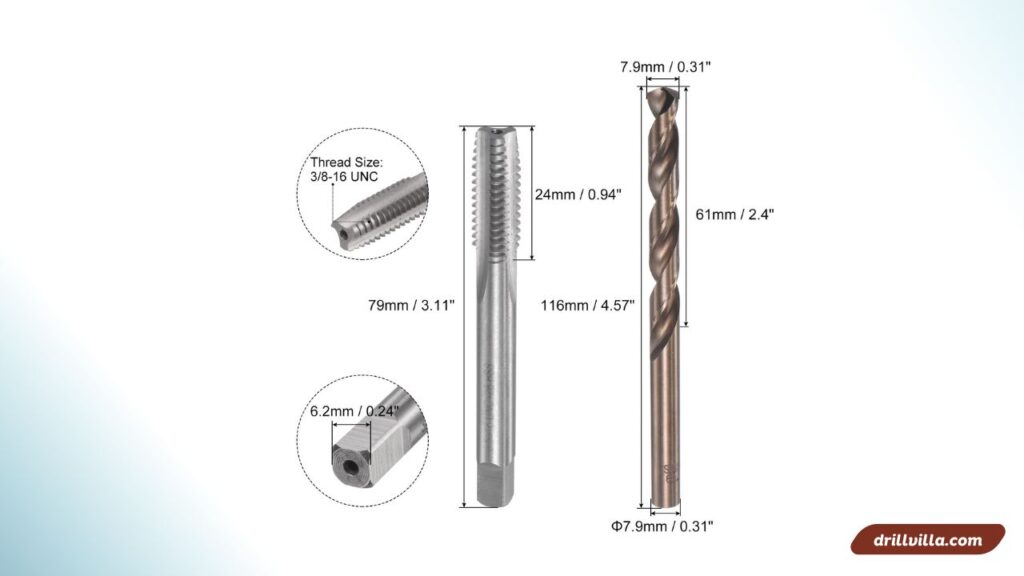When I first started tapping threads, I had no idea what size drill to use. Honestly, I thought I could just eyeball it. Big mistake. I stripped threads, cracked holes, and wasted materials. If you’ve ever asked yourself, “What drill size for 3/8-16 tap?”—you’re not alone.
Let’s walk through it together. I’ll keep it simple, real, and super beginner-friendly. I’ll share what worked for me, what didn’t, and what you need to know so you can get clean threads on your first try.
Article Summary
- What Does 3/8-16 Tap Even Mean?
- The Short Answer: What Drill Size for 3/8-16 Tap?
- Why Drill Size Matters
- How I Learned the Hard Way
- Pro Tips for Tapping Threads
- Tapping in Different Materials
- Tap Drill Size Chart for Common Sizes
- Common Questions I Had (And You Might Too)
- Tools I Use for Perfect Threading
- Mistakes to Avoid (Learned the Hard Way)
- Real-Life Application: Mounting a Winch on My Trailer
- What Size Drill Bit for 3/8-16 Tap in Steel?
- Drill Size for 3/8-16 Helicoil Tap
- Related Questions You Might Have
- Final Thoughts
What Does 3/8-16 Tap Even Mean?
Before jumping into drill sizes, let’s break down what “3/8-16” means:
- 3/8 = The nominal diameter of the screw or bolt (3/8 inch)
- 16 = The number of threads per inch (TPI)+

It’s a UNC thread, which stands for Unified National Coarse. That means the threads are spaced out wider compared to fine threads (UNF).
The Short Answer: What Drill Size for 3/8-16 Tap?
Use a 5/16-inch drill bit.
Yup, that’s it. Simple, right? But why? Let me explain…
Tapping Chart Reference
| Tap Size | Thread Pitch | Tap Type | Drill Size (inches) | Drill Size (mm) |
|---|---|---|---|---|
| 3/8-16 | 16 TPI | UNC | 5/16″ | 7.94 mm |
This size ensures you leave the right amount of material behind for the tap to cut into.
Why Drill Size Matters
You might be thinking, “Can’t I just use a drill bit that looks close enough?” Nope. Here’s why:
- Too Small? You’ll break the tap. I’ve done it. Twice.
- Too Big? Threads won’t grip, and the bolt will wiggle or strip.
Think of it like baking—too much flour or not enough, and your cake’s ruined. Same with drilling and tapping.
How I Learned the Hard Way
I remember working on a metal rack for my garage. I didn’t have a chart, so I grabbed the nearest bit. It was slightly smaller than 5/16”. As I turned the tap, I heard a crack—and that was it. Tap snapped. Hole ruined.
After some cursing and Googling, I learned about tap drill charts. They became my new best friend.
Pro Tips for Tapping Threads
Here’s what I’ve learned that can save you time, money, and frustration:
1. Always Use the Correct Drill Size
- 3/8-16 UNC? Use 5/16” drill bit.
- Mark your drill bits clearly so you don’t mix them up.
2. Use Cutting Fluid or Oil
- Keeps the tap cool
- Reduces friction
- Makes the process smoother
3. Tap Slow and Straight
- Don’t rush. Quarter turn in, then back it out a bit.
- Keeps threads clean and tap safe.
4. Use a Tapping Guide (Optional)
- Especially handy for beginners.
- Keeps the tap perfectly aligned.
Tapping in Different Materials
Not all materials are created equal. Here’s what I found from experience:
Soft Metals (Aluminum, Brass)
- Drill and tap like butter.
- Still use cutting oil, but you won’t need much force.
Harder Metals (Steel, Stainless)
- Use good quality taps—cheap ones snap easily.
- Pre-drill with a smaller bit first if needed.
Wood or Plastic?
- You can tap threads, but it’s not common.
- Use thread inserts or special screws instead.
Tap Drill Size Chart for Common Sizes
Here’s a quick tap drill size chart I keep taped to my toolbox:
| Tap Size | Thread Pitch | Drill Size (inch) | Notes |
|---|---|---|---|
| 1/4-20 UNC | 20 TPI | #7 (0.201”) | Very common |
| 5/16-18 | 18 TPI | F (0.257”) | Strong grip |
| 3/8-16 | 16 TPI | 5/16” (0.313”) | Use cutting fluid |
| 1/2-13 | 13 TPI | 27/64” | For heavy-duty |
Common Questions I Had (And You Might Too)
Can I use a metric drill bit for a 3/8-16 tap?
Yes, if it’s close. 8.0 mm is close to 5/16” (7.94 mm), so it works in a pinch. But stick with imperial if possible.
What if I accidentally used the wrong drill size?
- Too small? You may still tap it but risk breaking the tool.
- Too large? You’ll need to go up a tap size or use a thread insert (like a Helicoil).
What’s a thread insert?
A thread insert is a coiled or solid sleeve that you screw into a stripped hole to restore threads. Lifesaver, seriously.
Tools I Use for Perfect Threading
Here’s my personal setup:
- Tap and Die Set (with chart)
- Drill bit set (clearly labeled)
- Cutting oil (WD-40 works for light jobs)
- Tap wrench
- Thread gauge
I keep them all in a dedicated box. Makes grabbing the right tool fast and easy.

Mistakes to Avoid (Learned the Hard Way)
- Rushing the process
- Using dull taps
- Not backing out chips
- Forgetting lubricant
Seriously, even a bit of patience saves a whole lot of hassle.
Real-Life Application: Mounting a Winch on My Trailer
When I mounted a winch to my utility trailer, I had to tap 3/8-16 holes in a steel plate. I used:
- 5/16” drill bit
- Tap wrench
- Plenty of cutting oil
It worked perfectly. Bolts went in like butter and held tight during the first haul.
What Size Drill Bit for 3/8-16 Tap in Steel?
When I first had to tap a 3/8-16 hole in steel, I was a little nervous. Steel can be tough on bits, and I didn’t want to mess it up. So, I did a bit of digging and learned something simple but super useful: you need a 5/16″ drill bit.
Yep, that’s the magic number. Here’s why:
- A 3/8-16 tap means the screw is 3/8″ wide with 16 threads per inch.
- To make clean threads in steel, you need a drill size that removes just enough material, but not too much.
- If the hole is too small, the tap might snap. If it’s too big, your threads won’t hold tight.
Why 5/16″ Works Best in Steel
Using a 5/16″ drill bit gives you about 75% thread engagement, which is pretty much the gold standard. That means the threads are strong, but you’re not working the tap too hard.
I’ve tapped dozens of holes this way—into mild steel, angle iron, even thick plate—and 5/16″ has never failed me.
Pro tip: Use cutting oil and go slow. Especially with steel. Your tap (and your wrists) will thank you.
Quick Look: Tap and Drill Size Table
| Tap Size | Thread Count | Drill Bit (inch) | Thread % | Material |
|---|---|---|---|---|
| 3/8-16 | 16 TPI | 5/16″ | ~75% | Steel |
Important: If you’re using high-strength steel or stainless, you might want a tap with a spiral point or coated finish. And always use cutting fluid—trust me, it makes a world of difference.
Drill Size for 3/8-16 Helicoil Tap
Okay, now this one caught me off guard the first time.
I had stripped threads in a motorcycle engine cover. I knew a Helicoil insert could fix it, but I didn’t know what drill size to use. The tap said “3/8-16 Helicoil,” and I thought, “Cool, same drill size, right?”
Nope. It’s different.
Use a 25/64″ Drill Bit for a 3/8-16 Helicoil Tap
Yes, 25/64″. That’s a bit bigger than 5/16″. Here’s why:
- When using a Helicoil, you’re not just tapping for a screw—you’re tapping for the insert.
- The insert needs extra space to sit snug in the hole.
- The 3/8-16 Helicoil tap is not the same as a regular 3/8-16 tap. It cuts larger threads to hold the coil.
I had to go out and buy a 25/64″ drill bit just for this, but it was totally worth it.
Here’s What the Helicoil Kit Usually Includes:
- Special Helicoil tap (not standard 3/8-16)
- Wire coil insert
- Insertion tool
- Tang break tool
- Drill size recommendation (usually printed inside the case)
If you’re not sure, check the instructions that come with the kit. Most of them call for a 25/64″ drill bit, but always double-check.
Quick Table: Helicoil Drill Size Reference
| Helicoil Size | Thread Type | Drill Size (inch) | Use Case |
|---|---|---|---|
| 3/8-16 | UNC | 25/64″ | Thread repair in metal |
What Happens If You Use the Wrong Size?
I tried using a smaller bit once (oops), thinking it might be okay. It wasn’t.
- The tap got stuck halfway in.
- The threads didn’t cut clean.
- And the Helicoil wouldn’t fit.
It was a mess. I had to redrill and retap the whole thing. Lesson learned.
If it says 25/64″, trust it. Using the wrong size means you’ll be doing it twice.
Related Questions You Might Have
What drill size for 1/2-13 tap?
Use a 27/64” drill bit.
What is the difference between UNC and UNF threads?
UNC = coarse, UNF = fine. Coarse threads are more forgiving. Use UNC unless you have a specific reason.
Can I tap stainless steel with a regular tap?
You can, but use high-speed steel (HSS) taps and lots of oil
Final Thoughts
If you’re wondering what drill size for 3/8-16 tap, now you know: it’s 5/16”. I’ve been there, made mistakes, and now I keep it simple.
Just remember:
- Use the right drill size
- Go slow
- Don’t skip the oil
- Respect the tap
You’ll get perfect threads every time.
Know More:
- How Much Does It Cost To Drill A Bowling Ball?
- What Size Drill Bit for 10 Screw
- Are You Supposed To Submerge Powered Orthopedic Drills For Decontamination?
- A 135 Split Point Cobalt Letter Drill Bits?
- How Long Does It Take to Drill a Water Well?
- What Type of Drill Bits Won’t Snap?
- What Are the Best Drill Bits for Stainless Steel?